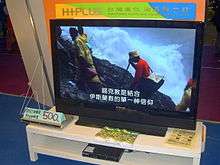Flat panel display

Flat-panel displays are electronic viewing technologies used to enable people to see content (still images, moving images, text, or other visual material) in a range of entertainment, consumer electronics, personal computer, and mobile devices, and many types of medical, transportation and industrial equipment. They are far lighter and thinner than traditional cathode ray tube (CRT) television sets and video displays and are usually less than 10 centimetres (3.9 in) thick. Flat-panel displays can be divided into two display device categories: volatile and static. Volatile displays require that pixels be periodically electronically refreshed to retain their state (e.g., liquid-crystal displays (LCD)). A volatile display only shows an image when it has battery or AC mains power. Static flat-panel displays rely on materials whose color states are bistable (e.g., e-book reader tablets from Sony), and as such, flat-panel displays retain the text or images on the screen even when the power is off. As of 2016, flat-panel displays have almost completely replaced old CRT displays. In many 2010-era applications, specifically small portable devices such as laptops, mobile phones, smartphones, digital cameras, camcorders, point-and-shoot cameras, and pocket video cameras, any display disadvantages of flat-panels (as compared with CRTs) are made up for by portability advantages (thinness and lightweightness).
Most 2010s-era flat-panel displays use LCD and/or LED technologies. Most LCD screens are back-lit as color filters are used to display colors. Flat-panel displays are thin and lightweight and provide better linearity and they are capable of higher resolution than typical consumer-grade TVs from earlier eras. The highest resolution for consumer-grade CRT TVs was 1080i; in contrast, many flat-panels can display 1080p or even 4K resolution. As of 2016, some devices that use flat-panels, such as tablet computers, smartphones and, less commonly, laptops, use touchscreens, a feature that enables users to select onscreen icons or trigger actions (e.g., playing a digital video) by touching the screen. Many touchscreen-enabled devices can display a virtual QWERTY or numeric keyboard on the screen, to enable the user to type words or numbers.
A multifunctional monitor (MFM) is a flat-panel display that has additional video inputs (more than a typical LCD monitor) and is designed to be used with a variety of external video sources, such as VGA input, HDMI input from a VHS VCR or video game console and, in some cases, a USB input or card reader for viewing digital photos). In many instances, an MFM also includes a TV tuner, making it similar to a LCD TV that offers computer connectivity.
History
The first engineering proposal for a flat-panel TV was by General Electric as a result of its work on radar monitors. Their publication of their findings gave all the basics of future flat-panel TVs and monitors. But GE did not continue with the R&D required and never built a working flat panel at that time.[1] The first production flat-panel display was the Aiken tube, developed in the early 1950s and produced in limited numbers in 1958. This saw some use in military systems as a heads up display, but conventional technologies overtook its development. Attempts to commercialize the system for home television use ran into continued problems and the system was never released commercially.[2] The Philco Predicta featured a relatively flat (for its day) cathode ray tube setup and would be the first commercially released "flat panel" upon its launch in 1958; the Predicta was a commercial failure. The plasma display panel was invented in 1964 at the University of Illinois, according to The History of Plasma Display Panels.[3] The first active-matrix addressed display was made by T Peter Brody's Thin-Film Devices department at Westinghouse Electric Corporation in 1968.[4] In 1977, James P Mitchell prototyped and later demonstrated what was perhaps the earliest monochromatic flat panel LED television display LED Display. As of 2012, 50% of global market share in flat-panel display (FPD) production is by Taiwanese manufacturers such as AU Optronics and Chimei Innolux Corporation.
Common types
Liquid crystal displays

Liquid crystal displays (LCDs) are lightweight, compact, portable, cheap, more reliable, and easier on the eyes than cathode ray tube screens. LCD screens use a thin layer of liquid crystal, a liquid that exhibits crystalline properties. It is sandwiched between two electrically conducting plates. The top plate has transparent electrodes deposited on it, and the back plate is illuminated so that the viewer can see the images on the screen. By applying controlled electrical signals across the plates, various segments of the liquid crystal can be activated, causing changes in their light diffusing or polarizing properties. These segments can either transmit or block light. An image is produced by passing light through selected segments of the liquid crystal to the viewer. They are used in various electronics like watches, calculators, and notebook computers.
Liquid crystal displays with light-emitting diode (LED) backlighting
Some LCD screens are backlit with a number of light-emitting diodes (LEDs). LEDs are two-lead semiconductor light source that resembles a basic "pn-junction" diode, except that an LED also emits light. This form of LCD (liquid crystal display) is the most prevalent in the 2010s. The image is still generated by the LCD.
Plasma panels
A plasma display consists of two glass plates separated by a thin gap filled with a gas such as neon. Each of these plates has several parallel electrodes running across it. The electrodes on the two plates are at right angles to each other. A voltage applied between the two electrodes one on each plate causes a small segment of gas at the two electrodes to glow. The glow of gas segments is maintained by a lower voltage that is continuously applied to all electrodes. In the 2010s, plasma displays have been discontinued by numerous manufacturers.
Electroluminescent panels
In an electroluminescent display (ELD), the image is created by applying electrical signals to the plates which makes the phosphor glow.
Organic light-emitting diode
An OLED (organic light-emitting diode) is a light-emitting diode (LED) in which the emissive electroluminescent layer is a film of organic compound which emits light in response to an electric current. This layer of organic semiconductor is situated between two electrodes; typically, at least one of these electrodes is transparent. OLEDs are used to create digital displays in devices such as television screens, computer monitors, portable systems such as mobile phones, handheld game consoles and PDAs. A major area of research is the development of white OLED devices for use in solid-state lighting applications.[1][2][3]
Quantum dot light emitting diode
QLED- QLED or Quantum Dot LED is a flat panel display technology introduced by Samsung under this trademark. Other television set manufacturers such as Sony have used the same technology to enhance the backlighting of LCD Television already in 2013.[5][6] Quantum dots create their own unique light when illuminated by a light source of shorter wavelength such as blue LEDs. This type of LED TV introduced by Samsung enhances the color gamut of LCD panels, where the image is still generated by the LCD. In the view of Samsung, quantum dot displays for large-screen TVs are expected to become more popular than the OLED displays in the coming years; they are so far rare, but seem potentially on the cusp of more widespread consumer take-up, with firms like Nanoco and Nanosys competing to provide the QD materials. In the meantime Samsung Galaxy devices such as smartphones are still equipped with OLED displays manufactured by Samsung as well. Samsung explain on their website that the QLED TV they produce can determine what part of the display needs more or less contrast. Samsung also announced a partnership with Microsoft that will promote the new Samsung QLED TV.
Volatile

Volatile displays require that pixels be periodically refreshed to retain their state, even for a static image. As such, a volatile screen needs electrical power, either from mains electricity (being plugged into a wall socket) or a battery to maintain an image on the display or change the image. This refresh typically occurs many times a second. If this is not done, for example, if there is a power outage, the pixels will gradually lose their coherent state, and the image will "fade" from the screen.
Examples
The following flat-display technologies have been commercialized in 1990s to 2010s:
- Plasma display panel (PDP)
- Active-matrix liquid-crystal display (AMLCD)
- Rear projection: Digital Light Processing (DLP), LCD, LCOS
- Electronic paper: E Ink, Gyricon
- Light-emitting diode display (LED)
- Active-matrix organic light-emitting diode (AMOLED)
- Quantum dot display (QLED)
Technologies that were extensively researched, but their commercialization was limited or has been ultimately abandoned:
- Active-matrix Electroluminescent display (ELD)
- Interferometric modulator display (IMOD)
- Field emission display (FED)
- Surface-conduction electron-emitter display (SED, SED-TV)
Static

Static flat-panel displays rely on materials whose color states are bistable. This means that the image they hold requires no energy to maintain, but instead requires energy to change. This results in a much more energy-efficient display, but with a tendency towards slow refresh rates which are undesirable in an interactive display. Bistable flat-panel displays are beginning deployment in limited applications (Cholesteric displays, manufactured by Magink, in outdoor advertising; electrophoretic displays in e-book reader devices from Sony and iRex; anlabels).
See also
- Computer monitor
- Display motion blur
- Electronic paper
- FPD-Link
- Flexible display
- Large-screen television technology
- LED-backlit LCD television
- Mobile display
- Sony Watchman
- Stereoscopy 3D displays requiring no special glasses
- Touch panel
- Transparent display
References
- ↑ "Proposed Television Sets Would Feature Thin Screens." Popular Mechanics, November 1954, p. 111.
- ↑ William Ross Aiken, "History of the Kaiser-Aiken, thin cathode ray tube", IEEE Transactions on Electron Devices, Volume 31 Issue 11 (November 1984), pp. 1605-1608.
- ↑ Plasma TV Science.org - The History of Plasma Display Panels
- ↑ Castellano, Joseph A. (2005). Liquid gold: the story of liquid crystal displays and the creation of an industry ([Online-Ausg.] ed.). New Jersey [u.a.]: World Scientific. p. 176. ISBN 981-238-956-3.
- ↑ CES 2015 placing bets on new TV technologies. IEEE Spectrum, January 7, 2015. Retrieved October 21, 2017
- ↑ LG leaps quantum dot rivals with new TV. CNET, December 16, 2014. Retrieved October 21, 2017
External links
| Wikimedia Commons has media related to Plasma displays. |
| Wikimedia Commons has media related to LCD computer monitors. |
| Wikimedia Commons has media related to LCD TVs. |
- TFT Central, flat panel monitor reviews, news and articles
- LED display, LED display system in China
- Finetech Japan, FDP exhibition and conference
- Feature: Strange Inventions You Never Knew About